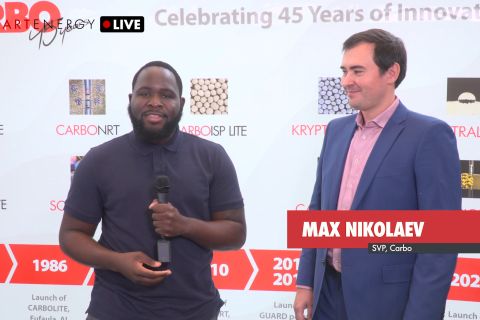Treating produced water and recycling spent flowback for use as fracturing fluid makeup water continues to interest operators and their service providers, particularly now as an area to reduce costs in light of recent oil prices. While it may not be all about cost, especially where the public demands environmental assurances and a certain quality of life, cost is of critical importance if the practice is to be sustained.
The industry continues to advance this technology on three primary fronts—improvements to fracturing fluids, improvements in produced water treatment and monitoring, and enhancing production with recycled produced water. The benefits realized in reducing the amount of freshwater used, the amount of trucking required and the immense quantities of produced water otherwise pumped into disposal wells speak well of the industry’s efforts to reduce costs, practice conservation and engage in efforts to sustain freshwater sources and disposal well resources.
Improvements in fracturing fluids
Any improvements to fracturing fluid are functions of (1) its chemistry; (2) the chemistry of everything it might come into contact with, such as the fracture string, the formation rock and reservoir fluids; and (3) the physical conditions imposed upon it. This is especially true for fluids originally developed for use with freshwater where freshwater can be replaced with a different quality of water. Because of its wellsite availability, produced water is the most likely choice for fracture makeup water. Produced water may be spent flowback, flowback containing daily increases of formation water and formation water largely devoid of any flowback. Each of these waters provides its own unique challenges due to their availability, chemistry, treatment and use as makeup water.
Flowback has variable but typically increasing total dissolved solids (TDS) from the first day of post-fracture production until the spent fracturing fluid is recovered. Formation waters have variable TDS as well, especially if one is operating in a field where the water from multiple producing zones is commingled. Figure 1 shows differences in produced water quality from wells just in the Permian Basin. If there is a constant here, it’s that the chemical composition of spent flowback is not only highly variable from well to well but from day to day to the point that constant variability is rapidly becoming a much greater issue in the development of treated recycled produced-water fracturing fluids than the particular chemical composition of the produced water.
| Parameter | Units | Brushy Canyon | Delaware Basin | Texas A&M West Texas Study (36 Flowback Samples from Various Locations) | |
|---|---|---|---|---|---|
| Conductivity | mS/cm | 257 | |||
| Total Dissolved Solids | mg/l | 267,588 | 2,900 | 252,000 | |
| Total Suspended Solids | mg/l | 10,623 | 10 | 13,762 | |
| Turbidity | NTU | 182 | |||
| Specific Gravity | 1.2000 | ||||
| Sodium | mg/l | 70,342 | 540 | 74,600 | |
| Potassium | mg/l | 1,660 | 28 | 5,770 | |
| Calcium | mg/l | 29,222 | 3,318 | 137 | 20,100 |
| Magnesium | mg/l | 4,347 | 140 | 20 | 1,690 |
| Barium | mg/l | 5.69 | 0 | 2,175 | |
| Strontium | mg/l | 2,204 | 0 | 5,049 | |
| Iron | mg/l | 34.60 | 1 | 0.3 | 114 |
| Chloride | mg/l | 163,637 | 62,569 | 1,200 | 153,000 |
| Bicarbonate Alkalinity | mg/l CaCO3 | 263 | 76 | 1,190 | |
| Carbonate Alkalinity | mg/l CaCO4 | 240 | 430 | ||
| Sulfate | mg/l | 40 | 0 | 0 | 2,000 |
| Silicate | mg/l | 0 | 41 | ||
| Boron | mg/l | 110 | 1 | 192 | |
| pH | 4.83 | 6.6 | |||
| Total Alkalinity | mg/l CaCO3 | 263 | 316 | 1,620 | |
FIGURE 1. This table compares Permian Basin formation and flowback water qualities. (Source: LeBas, et al., 2013; Federov and Cox, 2014; and Haghshenas and Nasr-El-Din, 2014)
A better approach might be to speak to the issue of water quality variability more specifically by pointing to water quality characteristics that detrimentally affect fracture fluid performance. It’s probably obvious to state, but any contaminant of pure water has the potential to detrimentally affect the performance of a fracturing fluid. However, not all contaminants negatively affect fluid performance in the same way nor at the same concentration.
Some contaminants may affect polymer hydration or polymer stability; still others may affect crosslinking reaction rate, stability at temperature or breaking. Some contaminants, like iron, may have a negative impact on crosslinked fracturing fluid performance at low concentrations, whereas sodium chloride (NaCl) may have little or no impact on certain crosslinked fluids at concentrations up to about 20%.
In Figure 2 the inverted ramp profiles for higher salinity are indicative of poor crosslinked fluid performance compared to those with a salinity less than 20%. Where the quality of the produced water might restrict the hydration viscosity of the guar and its subsequent crosslinked fluid performance, some service providers are merely adding more polymer to offset dilution or desalinization to reduce salinity. Others are developing crosslinked fluid systems that are more salinity-tolerant.

FIGURE 2. (Source: Rockwater Energy Solutions)
Carbonate and bicarbonate alkalinity can interfere with the hydration of guar and guar derivatives, while hardness ions such as calcium, magnesium, barite and strontium interfere with crosslinking. Bacteria are also a ubiquitous oilpatch problem, even in treated produced waters recycled for use as fracture makeup waters. And service providers usually report issues with polymer hydration if the boron content exceeds about 10 mg/l (37.9 mg/gal), and premature crosslinking in high pH fracturing fluids can become problematic when the boron concentration exceeds 20 mg/l to 25 mg/l (75.7 mg/gal to 94.6 mg/gal). Boron concentrations greater than 25 mg/l are commonly observed in the Eagle Ford, Cana Woodford and the Bakken.
Improvements in produced water treatment
Produced water treatment can be divided into two categories—whole-water and chemical addition. Filtration, electro-coagulation, electro-oxidation, distillation, ultraviolet irradiation and reverse osmosis are examples of whole-water treatments, where the entire water column is directly subjected to heat, an electric current, a membrane, etc. Chemical addition involves adding a substance to the water to be treated.
Whole-water processes are typically more costly than chemical additive treatment, but they are generally superior when it comes to demulsification; separating hydrocarbons from water; reducing total organic carbon; and reducing/removing hardness, total suspended solids and TDS.
Chemical additive treatments are usually constrained to delivering a biocide. Chlorine dioxide services endeavor to deliver both a biocide and the benefits of oxidation to the reduction of sulfides and the transformation of ferrous iron to ferric iron to improve the color and clarity of the water. Unfortunately, if the sulfates and the iron aren’t removed, the benefit is temporary, and these are highly likely to revert to hydrogen sulfide and iron sulfide once the water has been pumped back downhole. Adding filtration, the operations of which can be as much art as science, is helpful but not as complete as is possible in whole-water treatment processes.
Storage during the treatment process is perhaps as important a consideration as the selection of a treatment method. Whether it is to provide more consistent quality flowback to treat or to store treated water for reuse in fracturing, it is difficult to do better than to employ an above-ground storage tank (AST, Figure 3) to achieve and maintain homogeneity in water quality due to the size of the AST compared to a frack tank. Compared to standard frack tanks, water quality monitoring using ASTs requires far fewer sampling points and quality-control tests to assure consistency. Treated produced water stored in ASTs aids in optimizing bacteria-management practices for water held, sometimes for weeks, in advance of its use in fracturing.

FIGURE 3. ASTs at a fracturing job in the Uinta Basin are used to store treated and untreated produced water, providing a more consistent fluid. (Source: Rockwater Energy Solutions)
Treating to enhance production
While it is important to treat produced water for the criteria required of the fracturing fluid, it is even more important to treat to prevent scale and corrosion damage to the wellbore, limit damage to the proppant pack, mitigate formation damage and ultimately enhance production.
Some operators have actually reported improved results from wells fractured with treated produced water. One operator using a zirconium-crosslinked carboxymethylhydroxypropyl guar in treated produced water concluded, “Initial results indicate production aligns with that from offset wells fractured using 2% KCl [potassium chloride] as the base fluid.”
Another used a zirconium crosslinked guar in treated Bakken and Three Forks produced water to conclude, “The current production data suggest an advantage to well stimulation with produced water.”
Treatment operations to remove constituents that do not diminish the water’s use incur unnecessary costs associated with their removal as well as disposal. Returning treated produced water to the same formation while removing only suspended solids and treating for bacteria and perhaps boron would not only be less costly than reducing the TDS to drinking water quality levels but likely to be more formation-compatible.
References available.
Recommended Reading
Tech Trends: SLB's Autonomous Tech Used for Drilling Operations
2024-02-06 - SLB says autonomous drilling operations increased ROP at a deepwater field offshore Brazil by 60% over the course of a five-well program.
Tech Trends: Halliburton’s Carbon Capturing Cement Solution
2024-02-20 - Halliburton’s new CorrosaLock cement solution provides chemical resistance to CO2 and minimizes the impact of cyclic loading on the cement barrier.
ShearFRAC, Drill2Frac, Corva Collaborating on Fracs
2024-03-05 - Collaboration aims to standardize decision-making for frac operations.
Comstock Continues Wildcatting, Drops Two Legacy Haynesville Rigs
2024-02-15 - The operator is dropping two of five rigs in its legacy East Texas and northwestern Louisiana play and continuing two north of Houston.
Exclusive: Carbo Sees Strong Future Amid Changing Energy Landscape
2024-03-15 - As Carbo Ceramics celebrates its 45th anniversary as a solutions provider, Senior Vice President Max Nikolaev details the company's five year plan and how it is handling the changing energy landscape in this Hart Energy Exclusive.





